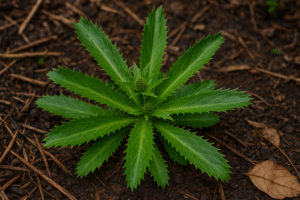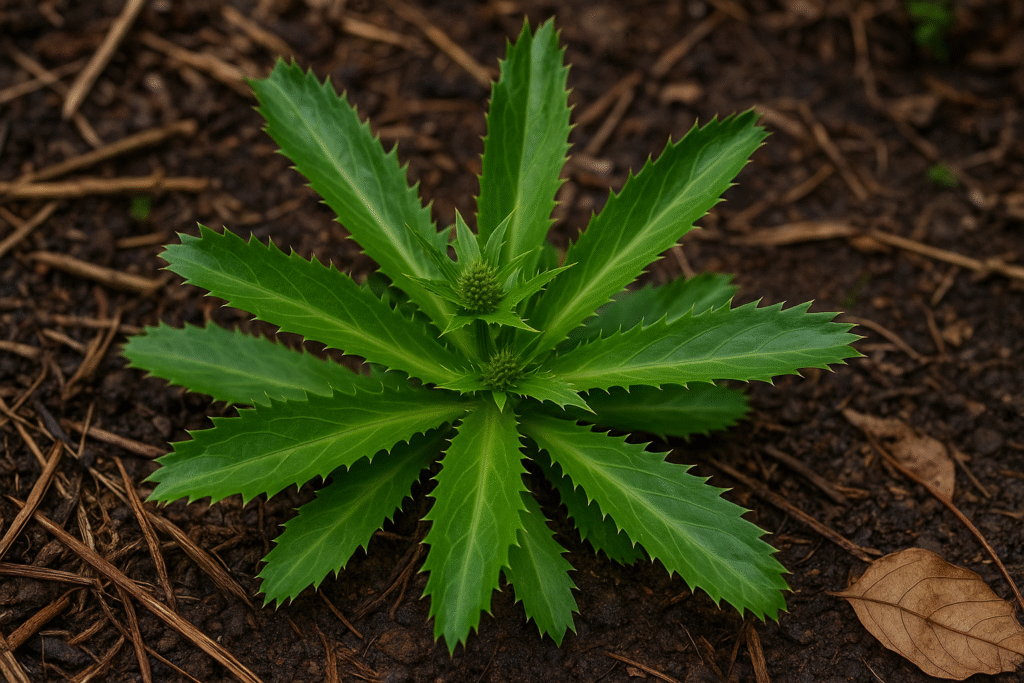Culantro (Eryngium foetidum), often referred to as Mexican coriander, long coriander, or even spiny coriander, is a tropical herb with a strikingly intense aroma and flavor that closely resembles traditional cilantro (Coriandrum sativum) — but stronger and more persistent. Native to Central and South America, culantro grows wild in moist, shaded areas and is commonly found in tropical climates. Though less mainstream than cilantro, it is gaining popularity in kitchens and home gardens around the world.
Botanical Characteristics of Culantro
Culantro is a perennial herb in the Apiaceae family, the same botanical family as parsley, celery, and fennel. The plant is easily identified by its long, serrated dark green leaves that form a rosette pattern. The edges of the leaves often have small spines, giving the plant a somewhat thistle-like appearance. In the center, it produces a spiky inflorescence composed of tiny white or greenish flowers.
Culantro is known for its hardiness and low maintenance, thriving in full sun or partial shade. It prefers moist, well-drained soils and can be grown both in open gardens and containers. Its strong scent, while pungent to some, is highly valued in many culinary traditions.
Culinary Uses and Intense Flavor
Culantro is widely used in traditional dishes across Latin America, the Caribbean, and Southeast Asia. In Puerto Rico and the Dominican Republic, it is a key ingredient in sofrito. In Trinidad and Tobago, it’s called “chadon beni”, and it flavors everything from stews to marinades. In Vietnam and Thailand, it goes by names like “ngo gai” and is added to soups, noodle dishes, and dipping sauces.
Compared to cilantro, culantro has a richer, muskier aroma and doesn’t lose its flavor when cooked — making it ideal for hot dishes like soups and curries. Just a few chopped leaves can completely transform the taste of a meal. It pairs well with garlic, onion, lime, and chili, and is perfect for seasoning beans, rice, fish, meats, and vegetables.
Medicinal Properties and Health Benefits
Aside from its culinary appeal, culantro has a long history in folk medicine. Traditional healers have used it for centuries due to its anti-inflammatory, analgesic, and antimicrobial properties. Here are a few common medicinal uses:
-
Digestive aid: Helps with indigestion, gas, and stomach cramps
-
Respiratory relief: Used in teas or infusions to relieve coughs, sore throats, and colds
-
Pain relief: Crushed leaves are applied topically to soothe headaches and muscle pain
-
Calming agent: Mild sedative effects help reduce stress and anxiety
Modern studies suggest that culantro contains several bioactive compounds, including flavonoids and essential oils, which may contribute to these therapeutic effects. However, it’s always advisable to consult a healthcare professional before using any herb for medicinal purposes.
Growing Culantro at Home
One of the greatest advantages of culantro is how easy it is to grow at home. It thrives in tropical and subtropical climates but can also adapt to indoor or greenhouse conditions in temperate regions.
You can grow culantro from seeds or starter plants. It prefers moist but well-drained soil, and while it tolerates full sun, it often grows best with a bit of afternoon shade. Water regularly, and trim off flowers to encourage more leaf growth.
Because of its attractive rosette shape and minimal care requirements, culantro is a perfect addition to kitchen gardens or herb planters, especially for cooks looking to expand their homegrown flavors beyond the usual basil and oregano.
Fun Facts and Additional Uses
-
Culantro’s strong scent makes it a natural insect repellent in garden settings.
-
In Caribbean and South American traditions, culantro is also used in spiritual baths to remove negative energy.
-
It can be blended with other herbs and spices to create homemade herb pastes, chutneys, or seasonings.

Elevate Your Herb Garden in Style
If you’re planning to grow culantro or any other herbs at home, why not display them beautifully? We recommend:
Bamworld Plant Stand – 3-Tier Indoor Outdoor Wooden Ladder Shelf for Multiple Plants, Boho Patio or Living Room Décor
This rustic, space-saving plant stand adds charm and structure to your space while keeping your herbs accessible and organized — perfect for kitchens, balconies, or patios!
🌿 Discover Another Powerful Medicinal Plant
If you’re fascinated by the healing power of herbs, don’t miss our full article on anise (Pimpinella anisum) — a fragrant plant known for its digestive and calming effects. Learn all about its uses, benefits, and historical curiosities!

